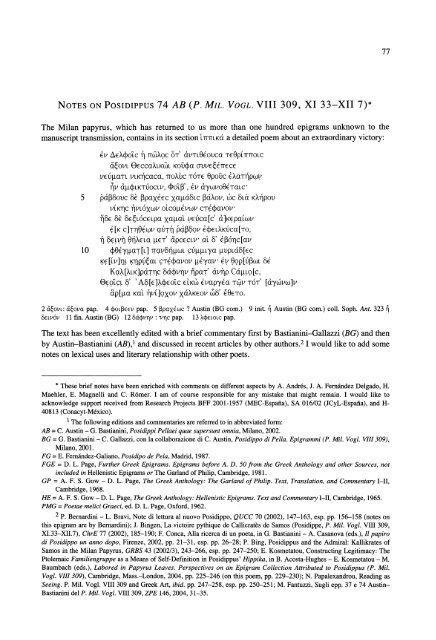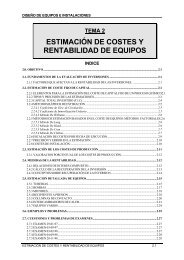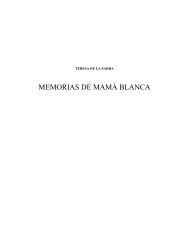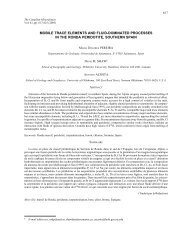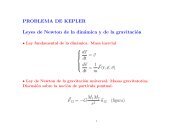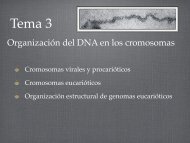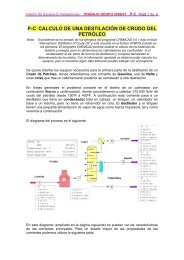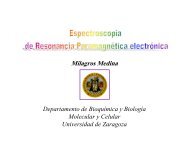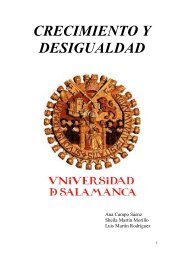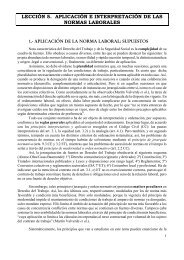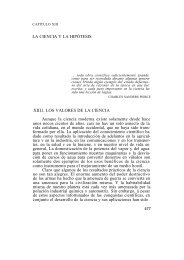P. Mil. Vogl. VIII 309, XI 33-XII 7 - Universidad de Salamanca
P. Mil. Vogl. VIII 309, XI 33-XII 7 - Universidad de Salamanca
P. Mil. Vogl. VIII 309, XI 33-XII 7 - Universidad de Salamanca
Create successful ePaper yourself
Turn your PDF publications into a flip-book with our unique Google optimized e-Paper software.
Notes on Posidippus 74 AB (P. <strong>Mil</strong>. <strong>Vogl</strong>. <strong>VIII</strong> <strong>309</strong>, <strong>XI</strong> <strong>33</strong>-<strong>XI</strong>I 7)*<br />
The <strong>Mil</strong>an papyrus, which has returned to us more than one hundred epigrams unknown to the<br />
manuscript transmission, contains in its section lttttlkc? a <strong>de</strong>tailed poem about an extraordinary victory:<br />
?v AeXc|)o?c f| ttooXoc ot ?vTiG?ouca TeGpiTTTTOic<br />
dc?ovL 6eccaXiK(joi KO?>|?aTi vLKf|caca, ttoX?c t?t? Gpo?c ?XaTrjpcjpv<br />
r\v ?|i(j)LKTi)OCLy, 4>oI?\ ?v ?ycovoG?Ta?c*<br />
5 pa?8ouc 8? ?paxeec xap-a?ic ?aXov,<br />
coc 8i? KXiqpou<br />
VLK1T|C flVL?XOOV OlCO|l?v?)V CT?(|>aVOV<br />
f\?e 8? 8e?ioceipa xa[?ai veyca[c ?]K paiQ)v<br />
?[k c]jriG?(jpy ocutti pa?8ov ec|>eiXid>ca[TO,<br />
f) Se.LVTl GrjXeia |i T ?pceciv ai 8' e?or)c[av<br />
10 4>0?y|jLaT[L] Trgv8f||JL(jOL a3[i|iiya |iupia8[ec<br />
k<br />
[lv]til KT]pv??aL ?T?(()avoy |i?yav<br />
ev<br />
Gopfu?coi 8e<br />
KgX[XiK]pcnr|c ' 8?$vr\v f\paf ?vfjp C?|iio[c,<br />
6eoici 8' A8[ ]Xcj) o?c eiK? evapy?a<br />
tgov t?t [aycovoajv<br />
?p[|ia Kai r\v?]oxpv x?XKeov (58' ?GeTO.<br />
2 afovi: d?ova pap. 4 c^oi?eev pap. 5 ?paxecoc ? Austin (BG com.) 9 ink. r\ Austin (BG com.) coll. Soph. Ant. 323 f?<br />
beiv?v 11 fin. Austin (BG) 12 8?(|>vr|v : -vnc pap. 13 Xc^etotc pap.<br />
The text has been excellently edited with a brief commentary first by Bastianini-Gallazzi (BG) and then<br />
by Austin-Bastianini (AB),1 and discussed in recent articles by other authors.21 would like to add some<br />
notes on lexical uses and literary relationship with other poets.<br />
*<br />
These brief notes have been enriched with comments on different aspects by A. Andr?s, J. A. Fern?n<strong>de</strong>z<br />
Delgado, H.<br />
Maehler, E. Magnelli and C. R?mer. I am of course<br />
responsible for any mistake that<br />
might remain. I would like to<br />
acknowledge support received from Research Projects BFF 2001-1957 (MEC-Espa?a), SA 016/02 40813 (Conacyt-M?xico).<br />
(JCyL-Espa?a), and H<br />
1<br />
The following editions and commentaries are referred to in abbreviated form:<br />
AB = C. Austin<br />
BG = G. Bastianini<br />
- G. Bastianini, Posidippi Pellaei quae supersunt omnia, <strong>Mil</strong>ano, 2002.<br />
- C. Gallazzi, con la collaborazione di C. Austin, Posidippo di Pella. Epigrammi (P. <strong>Mil</strong>. <strong>Vogl</strong>. <strong>VIII</strong><strong>309</strong>),<br />
<strong>Mil</strong>ano, 2001.<br />
FG = E. Fern?n<strong>de</strong>z-Galiano, Posidipo <strong>de</strong> Pela, Madrid, 1987.<br />
FGE = D. L. Page, Further Greek Epigrams. Epigrams before A. D. 50 from the Greek Anthology and other Sources, not<br />
inclu<strong>de</strong>d in Hellenistic Epigrams or The Garland of Philip, Cambridge, 1981.<br />
GP = -<br />
A. F. S. Gow D. L.<br />
Page, The Greek Anthology: The Garland of Philip. Text, Translation, and Commentary I?II,<br />
Cambridge, 1968.<br />
HE = A. F. S. Gow<br />
-<br />
D. L. Page, The Greek Anthology: Hellenistic Epigrams. Text and Commentary I?II, Cambridge, 1965.<br />
PMG = Poetae melici Graeci, ?d. D. L. Page, Oxford, 1962.<br />
2 P. Bernardini - L. Bravi, Note di lettura al nuovo Posidippo, QUCC 70 (2002), 147-163, esp. pp. 156-158 (notes on<br />
this epigram are by Bernardini); J. Bingen, La victoire pythique <strong>de</strong> Callicrat?s <strong>de</strong> Samos (Posidippe, P. <strong>Mil</strong>. <strong>Vogl</strong>. <strong>VIII</strong> <strong>309</strong>,<br />
<strong>XI</strong>.<strong>33</strong>-<strong>XI</strong>I.7), ChrE 11 (2002), 185-190; F. Conca, Alia ricerca di un<br />
poeta, in G. Bastianini<br />
-<br />
A. Casanova (eds.), II<br />
papiro<br />
di Posidippo<br />
un anno<br />
dopo, Firenze, 2002, pp. 21-31, esp. pp. 26-28; P. Bing, Posidippus and the Admiral: Kallikrates of<br />
Samos in the <strong>Mil</strong>an Papyrus, GRBS 43 (2002/3), 243-266, esp. pp. 247-250; E. Kosmetatou, Constructing Legitimacy: The<br />
Ptolemaic<br />
Familiengruppe<br />
as a Means of Self-Definition in<br />
Posidippus' Hippika,<br />
in B.<br />
Acosta-Hughes<br />
-<br />
E. Kosmetatou<br />
-<br />
M.<br />
Baumbach (eds.), Labored in Papyrus Leaves. Perspectives<br />
on an<br />
Epigram Collection Attributed to<br />
Posidippus (P. <strong>Mil</strong>.<br />
<strong>Vogl</strong> <strong>VIII</strong><strong>309</strong>), Cambridge, Mass.-London, 2004, pp. 225-246 (on this poem, pp. 229-230); N. Papalexandrou, Reading<br />
as<br />
Seeing. P. <strong>Mil</strong>. <strong>Vogl</strong>. <strong>VIII</strong> <strong>309</strong> and Greek Art, ibid. pp. 247-258, esp. pp. 250-251; M. Fantuzzi, Sugli epp. 37 e 74 Austin<br />
Bastianini <strong>de</strong>l P. <strong>Mil</strong>. <strong>Vogl</strong>. <strong>VIII</strong> <strong>309</strong>, ZPE 146, 2004, 31-35.<br />
77
78 L. A. Guichard Romero<br />
v. 2 ??ovi 6eccaXiKtoi. The synecdoche axle for chariot is guaranteed here by the well attested<br />
reputation of Thessalian race chariots (see BG p. 198); it appears in the same se<strong>de</strong>s m?trica only in<br />
Le?nidas 30 HE (AP 9. 24):<br />
"Acrrpa \iev r\\iavpi?oe Kai lepa K?KXa aeXfjvr|9<br />
d?;ova 8ivrjaa? c?|rrrupo? f) Xio?*<br />
ufivoTroXoDc 8' ayeXr|8?v ?irr\\ia\8vvev "Ofiipo?<br />
Xa|iTTp?TaToy Moixj?v c^?yyo? ?vaaxo|ievo?,<br />
on which Gow-Page comment: "?c;oya: for the whole chariot, though the word does not seem so used<br />
elsewhere". There are in fact no other loci similes for Le?nidas, except for this one now<br />
provi<strong>de</strong>d by<br />
Posidippus;3 synecdoche is actually<br />
a rhetorical issue very scarcely attested in<br />
Posidippus,<br />
a<br />
poet who<br />
prefers other forms of focalisation, as<br />
strong hyperbata and clear similes.4 As the literary context of<br />
both poems is very different and we are not<br />
completely certain about Le?nidas' chronology,5 direct<br />
imitation seems very difficult to prove in this case. It is possible that both poets coined this as a<br />
variation of the well known figure of cxvtuc; referring to the whole chariot,6 as attested from Sophocles<br />
to Callimachus.7 Le?nidas and Posidippus may have used a prosaic term instead of the expected<br />
poeticism.<br />
v. 2 KoucJ)a awe?c?TT ce. Cfr. Asclepia<strong>de</strong>s 6 HE (AP 5. 203):<br />
Aixji8lkt| (Jol, Kimpi, t?v LTTTTacnT?pa {iv??ttol<br />
Xp?aeov c??Kvr||iou KevTpov Gt|kc? tto8o?,<br />
(S ttoXw ?TTTiov LTTTTOv<br />
?yv\ivaoev, o?8? tot' auTfjs<br />
|ir|po? ec^OLVLXOTi Ko?(j)a TLvaaao|i?vr|?.<br />
f?v y?p aK?vTr|TO? TeXc?o8p?|ioc, oweKev ?ttXov<br />
aoi KaT? |jic?aaoTTi3Xr|? xP^aeoy ?Kp?[iaoev.<br />
It does not seem to be a coinci<strong>de</strong>nce that the adverb Ko?(|)a appears in verse 4 at the same se<strong>de</strong>s of the<br />
pentameter and that this occurs only in these two passages.8 The close relationship between these two<br />
3<br />
Searching in TLG-E CD-Rom and in the most reliable dictionaries (Stephanus, DGE, LSJ, LfgrE) reinforces the<br />
opinion of Gow-Page. It is worth noting another text of Le?nidas, 73 HE (AP 1. 478) 3-4: |ivfj[ia 8? Kai Tao? ai?v<br />
?\iat; vovTO
Notes on Posidippus 74 AB 79<br />
poets is well known, both in matters of metrics, style and literary program.9 Asclepia<strong>de</strong>s 6 HE (AP 5.<br />
203) and *35 HE (AP 5. -<br />
202) ascribed in the manuscript transmission to Asclepia<strong>de</strong>s<br />
or<br />
Posidippus<br />
but in the opinion of most scholars a work of the latter10 - are both parodies with erotic double entendre<br />
of equestrian competitions in which women take a<br />
part (the second including<br />
a cru<strong>de</strong> parody of a verse<br />
from Callimachus' fifth hymn), for which the epigrams in section iTrmKa<br />
give the serious mo<strong>de</strong>l we<br />
were missing. It is now clear that Asclepia<strong>de</strong>s<br />
activity.11<br />
uses Ko?c|>a as related to equestrian<br />
as much as to erotic<br />
v. 9 f| 8c?Lvf] GtiXeia |i T apceciv. There is no strong evi<strong>de</strong>nce to <strong>de</strong>ci<strong>de</strong> between conjectures f), adopted<br />
in the text of BG and AB, and fj, suggested by Austin in the critical apparatus of the latter. In any case,<br />
the wording 8eivfi GrjXeia does not have an exact parallel,<br />
as already noted by the editors (BG)\ it is<br />
possible, however, that in its origin there could be a variation on the well known Seivo? ?vr|p,12 an<br />
expression which originally had an<br />
epic taste,13 which could reinforce the contrast in this poem:<br />
Posidippus<br />
and force,<br />
does<br />
but<br />
not only<br />
reverse the gen<strong>de</strong>r to<br />
emphasize the courage and force of Callicrates' mare<br />
-<br />
through<br />
-<br />
\iej apceciv he also compares it with the lack of both virtues in her male<br />
rivals; from this point of view, it is worth remembering the appeal of Antilochus to his horses in //. 23.<br />
407^09:<br />
LTTTTOD? 8'<br />
'<br />
ATp l8aO KlXCtV T , |!T|8? XlTnT|(jG0V,<br />
KapTTaX[|i(j??, [if] acJxj?LV ?Xeyx LT|v KaTaxe?q<br />
Al0t| GfjXu? ?o?aa.<br />
The special merits of Aithe are mentioned again at vv. 524-525,14<br />
while at vv. 375-378 a clear contrast<br />
is drawn between Eumelos' mares and Diome<strong>de</strong>s' horses (v. 377: ?poeve? "ittttoi). Popular wisdom<br />
attributed to mares<br />
special virtues, different from those of horses, and mares were sometimes consi<strong>de</strong>red<br />
better than males in chariot competitions.15 Mares have a relevant role in two other epigrams of the<br />
section LTTTTiKa:<br />
75 AB (<strong>XI</strong>I 8-11), on chariot mares winning many times, and 87 AB (<strong>XI</strong>II 31-34), on<br />
Berenice's mares having eclipsed the glory of Cyniska, the first woman to win in the games. The image<br />
of the brave mare is somehow paralleled with the victories of the Ptolemaic Princesses and Queens: the<br />
last epigram of the section (88 AB = <strong>XI</strong>II 35-<strong>XI</strong>V 1) says that Ptolemy I, Berenice I and Ptolemy II are<br />
the first and only (v. 1 up?Toi Tpelc<br />
the feminine victory (vv. 4-5: on |icrnr|p / elXe yvv?<br />
wins Qr\Xv?XXeTO y?p Li?vos" r\v I lttttou<br />
Tfj? 'Ayau?|ivov?r|? raXX?Tpixo? Al0r|?. "The mare is<br />
dignified in a whole<br />
verse<br />
<strong>de</strong>scription",<br />
comments Richardson ad loc.<br />
15<br />
Cfr. Aelian N. A. 2. 10; 3. 8; 4. 11; 6. 48; 12. 16; 12. 44; 14. 18; 15. 25; 16. 24. See also the evi<strong>de</strong>nce collected by U.<br />
Dierauer, Tier und Mensch im Denken <strong>de</strong>r Antike, Amsterdam, 1977, specially pp. 47, 145-146, 163, 266 and 271.<br />
16<br />
It is also worth of note that the wording appears again in Homer only<br />
at //. 19. 97, where Zeus is <strong>de</strong>ceived by Hera<br />
0f|Xu? ?o?cra. The strong presence of the feminine in the form of <strong>de</strong>ified Queens and athletic<br />
competitions<br />
won<br />
by<br />
women in<br />
the <strong>Mil</strong>an Papyrus was noted by P. Bing, Posidipppus on Stones: The First Section of the New Posidippus' Papyrus (P. <strong>Mil</strong>.
80 L. A. Guichard Romero<br />
v. 13 LK(JL)<br />
?vapy?a. The editors comment that these words are used in senso figurato in late texts<br />
(Philo, Dio Chrysostomus and Clement of Alexandria). In the context of the epigram, it is easier to<br />
un<strong>de</strong>rstand these words in their usual meaning in ekphrastic epigrams. As Bernardini pointed out,<br />
Posidippus is probably referring here to a real sculpture group.17 This interpretation<br />
seems correct in<br />
view of the votive nature of the epigram, revealed in the last distich, and also the use of both words as<br />
technical terms in epigrams related to works of art. Elkwv is well attested as a terminus technicus in<br />
Meleager's Garland. See e. g. Noss. 6 HE (AP 9. 605) 2; Noss. 9 HE (AP 6. 354) 2; Call. 20 HE (AP<br />
13. 24) 2; Theoc. 15 HE (AP 9. 599) 3, and Mel. 110 HE (AP 12. 56) 1. 'Evapy^? appears in the<br />
Garland of Philip and later: Antiphil. 17 GP (AP 1. 641) 5, an ekphrasis of a water clock, and Plan.<br />
225. 1, a <strong>de</strong>scription of a sculpture of Pan; the related term ?vapy?? is used in Plan. 310. 3, a <strong>de</strong>scrip<br />
tion of a statue of Sappho; in each case it qualifies the ekphrasis.19 As A. Manieri shows in her<br />
exhaustive study,20 ? va pyfj? and related adjectives indicate "una qualit? di animazione ed evi<strong>de</strong>nza<br />
visiva, quasi di immagine in movimento"; ?vapyeia is thus the quality that differentiates ekphrasis from<br />
other exercises; it is the virtue pursued by poets and sculptors. Using these two technical terms,<br />
Posidippus emphasizes the perfection and life-likeness of the sculpture offered to the Sibling Gods.<br />
<strong>Universidad</strong> <strong>de</strong> <strong>Salamanca</strong> Luis Arturo Guichard Romero<br />
<strong>Vogl</strong>.<br />
<strong>VIII</strong> <strong>309</strong>, col. I-IV. 6), a paper presented<br />
to the APA Conference in Phila<strong>de</strong>lphia (5. 1. 2002), and published<br />
http://apaclassics.org/Publications/Posidippus/posidippus.html.<br />
17<br />
To support her interpretation,<br />
Bernardini quotes only Pi. 01.1. 42: ?coji?v ?vapy?a.<br />
18<br />
The following survey comes from F. Manakidou, Beschreibung<br />
von Kunstwerken in <strong>de</strong>r hellenistischen Dichtung,<br />
Stuttgart, 1993, p. 260; the author refers to another four examples in the Garland of Philip (pp. 261-262): Diod. 18 GP (AP<br />
9. 776) 4; Philipp. 67 GP (Plan. 81) 1; Philipp. 70 GP (Plan. 137) 1; Bianor 22 GP (Plan. 276) 1; one in FGE:<br />
FGE (Plan. 160) 2, and the school poem edited as SH 978. 12.<br />
'Plat.' 23<br />
19 See<br />
especially<br />
Aubreton's notes (?d. Belles-Lettres) to Plan. 225. 1, in which is drawn a clear contrast between<br />
?vapy?a / ?vcoc|>eX?a and TrveOua / ?\LT\xav?S<br />
20 A. Manieri, Uimmagine po?tica nella teoria <strong>de</strong>gli antichi. Phantasia ed enargeia, Pisa-Roma, 1998, pp. 98-99; on<br />
enargeia and ekphrasis, pp. 149-154.<br />
as


